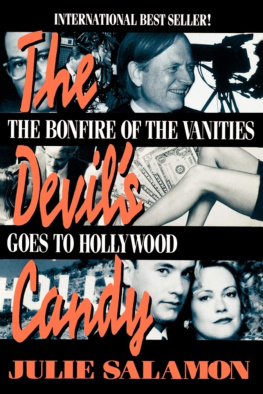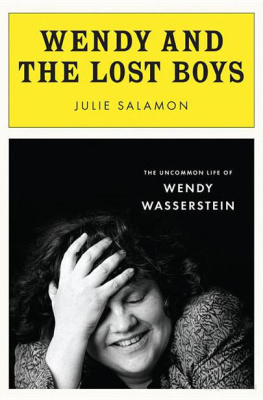Tke Devil's Cand
Books by Julie Salamon
White Lies The Devil's Candy
The
Devil's Candy
The Bonfire of the Vanities Goes to Hollywood
Julie Salamon
HOUGHTON MIFFLIN COMPANY Boston
Copyright 1991 by Julie Salamon All rights reserved
For information about permission to reproduce selections from this book, write to Permissions, Houghton Mifflin Company, 2.15 Park Avenue South, New York, New York 10003.
CIP data is available.
ISBN 0-395-56996-6
Printed in the United States of America
bp 10 98765432
To Bill and Roxie
CONTENTS
The Players ix Prologue xi
PART i
Preproduction
The Devil s Candy 3
Great, Great, Great 19
Head Bangers 39
The Magic Hour 64
On Medicis, X-rays, and Bloody Fruit Flies
The War Zone 107
PART 11
The New York Shoot
Forty Million Dollars of Transformation 1
Silly Season in the Bronx 141
Demented Optimism 165
Wire Without a Net 194
PART III
The Los Angeles Shoot
Hollywood Way 229
Leading Ladies 257
Nickel and Diming 289
PART IV Postproduction
This Is the Best Movie We Ever Made
It s in Your Bones 353
Junketeers 375
You ve Got to Be a Genius to Make
a Movie This Bad
Author s Note 421 Index 424
THE PLAYERS
THE CREW
Brian De Palma
Director and Producer
Eric Schwab
Second Unit Director
Fred Caruso
Co-Producer
Richard Sylbert
Production Designer
Ann Roth
Costume Designer
Vilmos Zsigmond
Cinematographer
Monica Goldstein
Associate Producer
Aimee Morris
Production Assistant
Karl Slovin
Production Assistant
Doug Rushkoff
AFI Intern
David Ray
Editor
Bill Pankow
Editor
Lynn Stalmaster
Casting Director
Nancy Hopton
Script Supervisor
Doug Ryan
Camera Operator
Larry McConkey
Steadicam Operator
Chris Soldo
First Assistatit Director
Peter Runfolo
Unit Production Manager, New York
Dave Grusin
Composer
Else Blangsted
Editorial Music Consultant
Elisha Birnbaum
Foley Artist
Maurice Schell
Supervising Sound Editor
Gary Jones
Assistant Costume Designer
Cara Silverman
First Assistant Film Editor
Ray Hubley
First Assistant Film Editor
Bruce Frye
Location Scout
Darren Wiseman
Location Scout
Brett Botula
Location Manager
Randy Bowers Eddie Iacobelli Rob Harris
THE CAST
Tom Hanks Bruce Willis Melanie Griffith Morgan Freeman Beth Broderick Kim Cattrall Alan King Rita Wilson Andre Gregory
THE STUDIO
Lucy Fisher Mark Canton
Rob Friedman
Terry Semel
Robert A. Daly
Bill Young Ron Smith
THE EXTRAS
Peter Guber
Tom Wolfe
Judge Burton Roberts
Michael Cristofer Marty Bauer Steven Spielberg Dawn Steel
Bruce Willis s Stand-in Transportation Coordinator Unit Publicist
Sherman McCoy Peter Fallow Maria Ruskin Judge Leonard White Caroline Heftshank Judy McCoy Arthur Ruskin PR. Lady Aubrey Buffing
Executive Vice President, Production Executive Vice President, Worldwide Motion Picture Production President, Worldwide Theatrical Advertising and Publicity President and Chief Operating Officer, Warner Bros., Inc.
Chairman and Chief Executive Officer, Warner Bros., Inc.
Vice President, Production Bonfire Production Executive
Executive Producer Author
Model for Judge Kovitsky, the Model for Judge White Screenwriter Agent
Brian De Palma s Best Friend Former Head of Columbia Pictures
PROLOGUE
A genteel murmur presided in the dining room of the Carlyle Hotel, at Seventy-sixth and Madison Avenue, on the Upper East Side of Manhattan. There was, naturally, a certain bustle at breakfast as the well-groomed patrons of this refined enclave made their way to the buffet table. But there was none of the purposeful table-hopping that was so noticeable at Park Avenues Regency Hotel, known for the power breakfasts of its Wall Street and entertainment industry clientele. Discretion ruled the Carlyle, where the bellhops wore white gloves and the opulence was obvious yet understated, and the mood cheery yet subdued.
Dominating the center of the room was a huge Japanese iron vase filled with a luxurious spray of bright flowers. The walls were covered with subtle brown linen velvet and nineteenth-century English hunting prints. For more intimate conversation, one could move into one of the smaller offshoots of the main room into the smoking room, with its fussy, fabric-lined walls and eighteenth- century French redout floral prints, or into the Chinese room, named for its decorative Oriental silk screens. Everything was just so. The china was Villeroy and Boch, the silver was Chambly. The Louis XV furniture completed the sensation that manners as well as money still mattered here.
This stronghold of luxe Victoriana was one of the few places in New York City circa 1990 where Tom Wolfe didn t look like an anachronism. Dressed, distinctively as always, in a three-piece gray-plaid suit, a cream-colored shirt with an old-fashioned highnecked cut, and shoes designed to look as though they sported
spats, he spoke in a mild voice, touched slightly by a Virginia accent. With his soft, pale face and fine, graying hair, the author appeared delicate, slightly otherworldly.
It was difficult to connect this frail, courtly gentleman with the glinting satirical wit that had made him one of the most famous writers in America. Could this meticulous dandy really be the same man who composed the sixth spoken line in the best-selling novel The Bonfire of the Vanities: Heh-heggggggggggggggggghhhhh- hhhhhhhhhh! That was it. The entire thought. Heh-heggggggg - gggggggggghhhhhhhhhhhhhhhr And Bonfire was only the latest example of Wolfe s singular style. For twenty-five years as a journalist hed gleefully jabbed at the pretensions of the American middle and upper classes especially the New York intelligentsia. Hed merrily debunked The New Yorker , the Bauhaus movement, liberal chic, and Freud with uniquely rambunctious prose and enthusiastic punctuation.
That morning the slender, contradictory man was eating grain cereal with stewed fruit and speaking in a thoughtful, slightly formal fashion about how the people from Hollywood were progressing with the movie version of The Bonfire of the Vanities. He mentioned diplomatically that they were being attentive to details.
I must confess I get my shoes made at New & Lingwood, Wolfe said, dropping the name of the London fabricator of two- thousand-dollar-a-pair men s shoes with his cultivated mixture of snobbery and modesty. And the salesman was here in New York, and he said that Tom Hanks had arrived and wanted two pairs of shoes for the movie Tom Hanks or whoever was buying shoes for him and asked the salesman what kind should we get? And the salesman says, Well, in the book it says half-brogues, and the movie person says, Okay, give us those. I was rather impressed by that because, unless they make a point of it in the script to have the camera focus on the shoes, who s going to know? You have to have a very picky eye like myself to sit around and figure out where the shoes are from. They seem to be concerned with accuracy in certain respects.
He wasn t willing to criticize the moviemakers just yet. I think it s bad manners in the Southern sense to be sharp and critical of it, he said. I did cash the check. However, with his good Southern manners the author had made it clear to the Hollywood people right after he accepted the $750,000 they paid him for the rights to his book that he didn t want to have anything to do with the making of their movie.
Next page








